The Cambridge History of China. Vol. 12: Republican China, 1912-1949, Part 1
Подождите немного. Документ загружается.

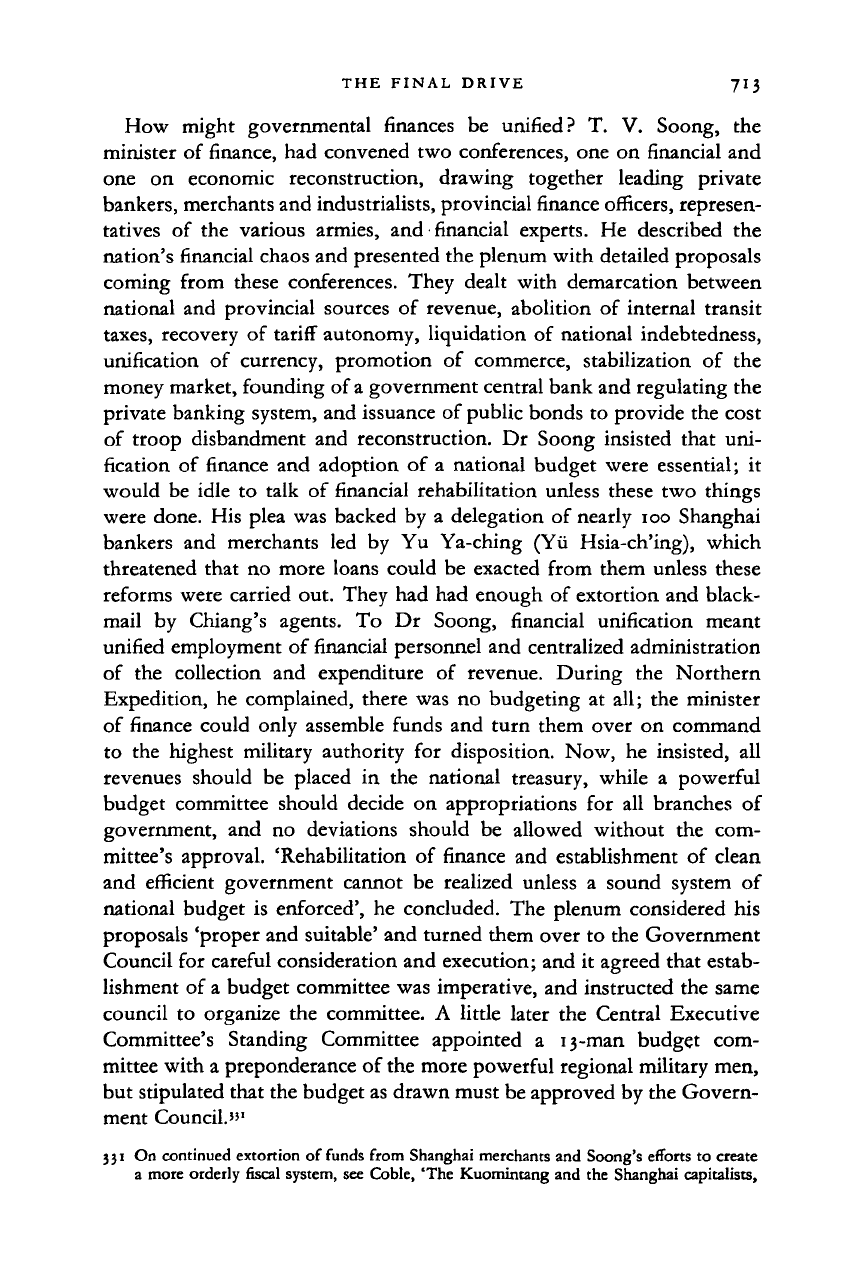
THE FINAL DRIVE 713
How might governmental finances be unified? T. V. Soong, the
minister of finance, had convened two conferences, one on financial and
one on economic reconstruction, drawing together leading private
bankers, merchants and industrialists, provincial finance officers, represen-
tatives of the various armies, and financial experts. He described the
nation's financial chaos and presented the plenum with detailed proposals
coming from these conferences. They dealt with demarcation between
national and provincial sources of revenue, abolition of internal transit
taxes,
recovery of tariff autonomy, liquidation of national indebtedness,
unification of currency, promotion of commerce, stabilization of the
money market, founding of
a
government central bank and regulating the
private banking system, and issuance of public bonds to provide the cost
of troop disbandment and reconstruction. Dr Soong insisted that uni-
fication of finance and adoption of a national budget were essential; it
would be idle to talk of financial rehabilitation unless these two things
were done. His plea was backed by a delegation of nearly ioo Shanghai
bankers and merchants led by Yu Ya-ching (Yii Hsia-ch'ing), which
threatened that no more loans could be exacted from them unless these
reforms were carried out. They had had enough of extortion and black-
mail by Chiang's agents. To Dr Soong, financial unification meant
unified employment of financial personnel and centralized administration
of the collection and expenditure of revenue. During the Northern
Expedition, he complained, there was no budgeting at all; the minister
of finance could only assemble funds and turn them over on command
to the highest military authority for disposition. Now, he insisted, all
revenues should be placed in the national treasury, while a powerful
budget committee should decide on appropriations for all branches of
government, and no deviations should be allowed without the com-
mittee's approval. 'Rehabilitation of finance and establishment of clean
and efficient government cannot be realized unless a sound system of
national budget is enforced', he concluded. The plenum considered his
proposals 'proper and suitable' and turned them over to the Government
Council for careful consideration and execution; and it agreed that estab-
lishment of a budget committee was imperative, and instructed the same
council to organize the committee. A little later the Central Executive
Committee's Standing Committee appointed a 13-man budget com-
mittee with a preponderance of the more powerful regional military men,
but stipulated that the budget as drawn must be approved by the Govern-
ment Council."
1
331 On continued extortion of funds from Shanghai merchants and Soong's efforts to create
a more orderly fiscal system, see Coble, 'The Kuomintang and the Shanghai capitalists,
Cambridge Histories Online © Cambridge University Press, 2008
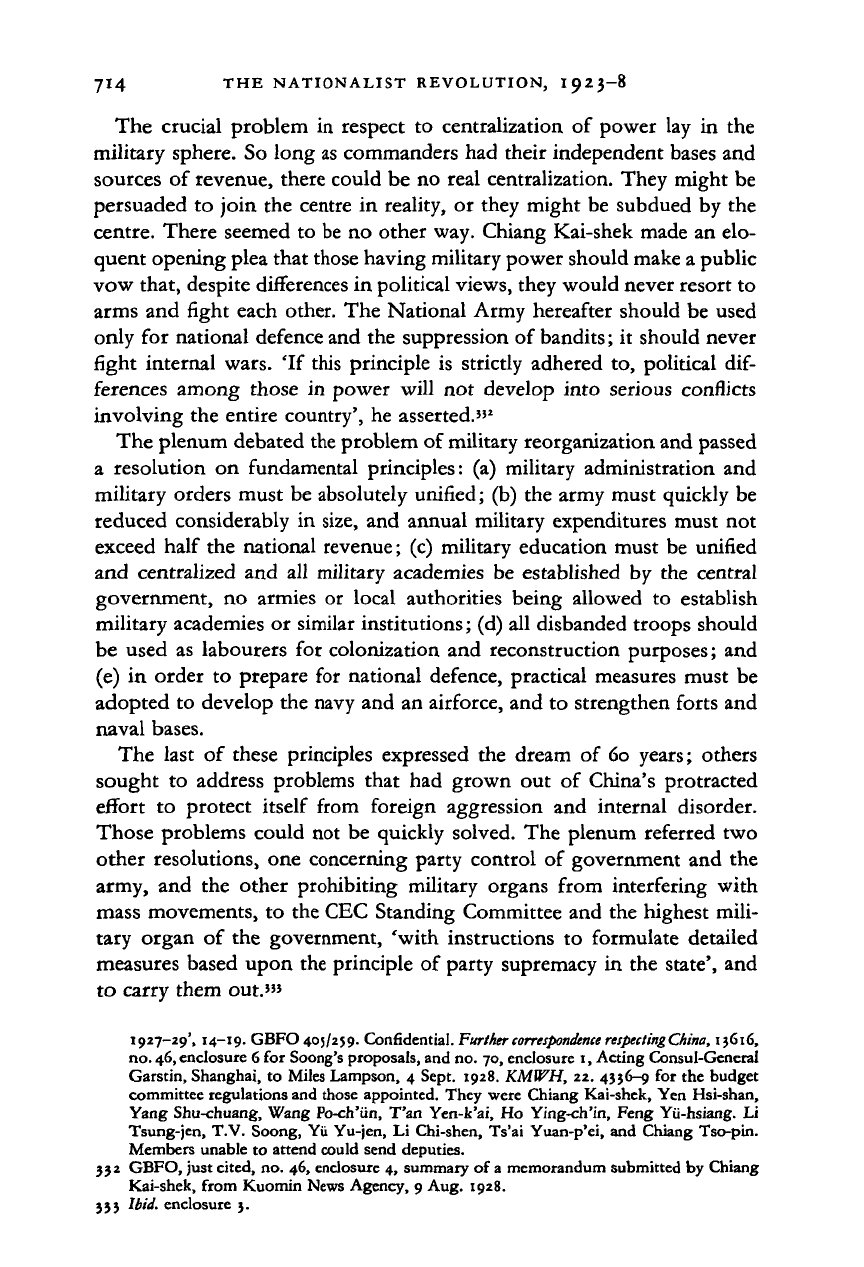
714 THE NATIONALIST REVOLUTION, 1923-8
The crucial problem
in
respect
to
centralization
of
power lay
in the
military sphere. So long as commanders had their independent bases and
sources
of
revenue, there could be no real centralization. They might be
persuaded
to
join the centre
in
reality,
or
they might be subdued by the
centre. There seemed to be no other way. Chiang Kai-shek made an elo-
quent opening plea that those having military power should make a public
vow that, despite differences in political views, they would never resort to
arms and fight each other. The National Army hereafter should be used
only
for
national defence and the suppression of bandits;
it
should never
fight internal wars.
'If
this principle
is
strictly adhered to, political
dif-
ferences among those
in
power will
not
develop into serious conflicts
involving the entire country', he asserted."
2
The plenum debated the problem of military reorganization and passed
a resolution
on
fundamental principles:
(a)
military administration and
military orders must be absolutely unified; (b) the army must quickly be
reduced considerably
in
size, and annual military expenditures must not
exceed half the national revenue; (c) military education must be unified
and centralized and
all
military academies
be
established
by
the central
government,
no
armies
or
local authorities being allowed
to
establish
military academies
or
similar institutions; (d) all disbanded troops should
be used
as
labourers for colonization and reconstruction purposes; and
(e)
in
order
to
prepare
for
national defence, practical measures must
be
adopted to develop the navy and an airforce, and to strengthen forts and
naval bases.
The last
of
these principles expressed the dream
of
60 years; others
sought
to
address problems that had grown
out of
China's protracted
effort
to
protect itself from foreign aggression
and
internal disorder.
Those problems could not
be
quickly solved. The plenum referred two
other resolutions, one concerning party control
of
government and the
army,
and the
other prohibiting military organs from interfering with
mass movements,
to
the CEC Standing Committee and the highest mili-
tary organ
of
the government, 'with instructions
to
formulate detailed
measures based upon the principle
of
party supremacy
in
the state', and
to carry them out."
5
1927—29', 14-19. GBFO 405/259. Confidential.
Further correspondence respecting
China,
15616,
no.
46, enclosure
6
for Soong's proposals, and no. 70, enclosure 1, Acting Consul-General
Garstin, Shanghai,
to
Miles Lampson,
4
Sept. 1928.
KMWH,
22. 4356-9 for the budget
committee regulations and those appointed. They were Chiang Kai-shek, Yen Hsi-shan,
Yang Shu-chuang, Wang Po-ch'un, T'an Yen-k'ai,
Ho
Ying-ch'xn, Feng Yii-hsiang.
Li
Tsung-jen, T.V. Soong, Yii Yu-jen,
Li
Chi-shen, Ts'ai Yuan-p'ei, and Chiang Tso-pin.
Members unable
to
attend could send deputies.
3 32 GBFO, just cited, no. 46, enclosure 4, summary
of
a memorandum submitted by Chiang
Kai-shek, from Kuomin News Agency,
9
Aug. 1928.
333
Ibid,
enclosure
3.
Cambridge Histories Online © Cambridge University Press, 2008
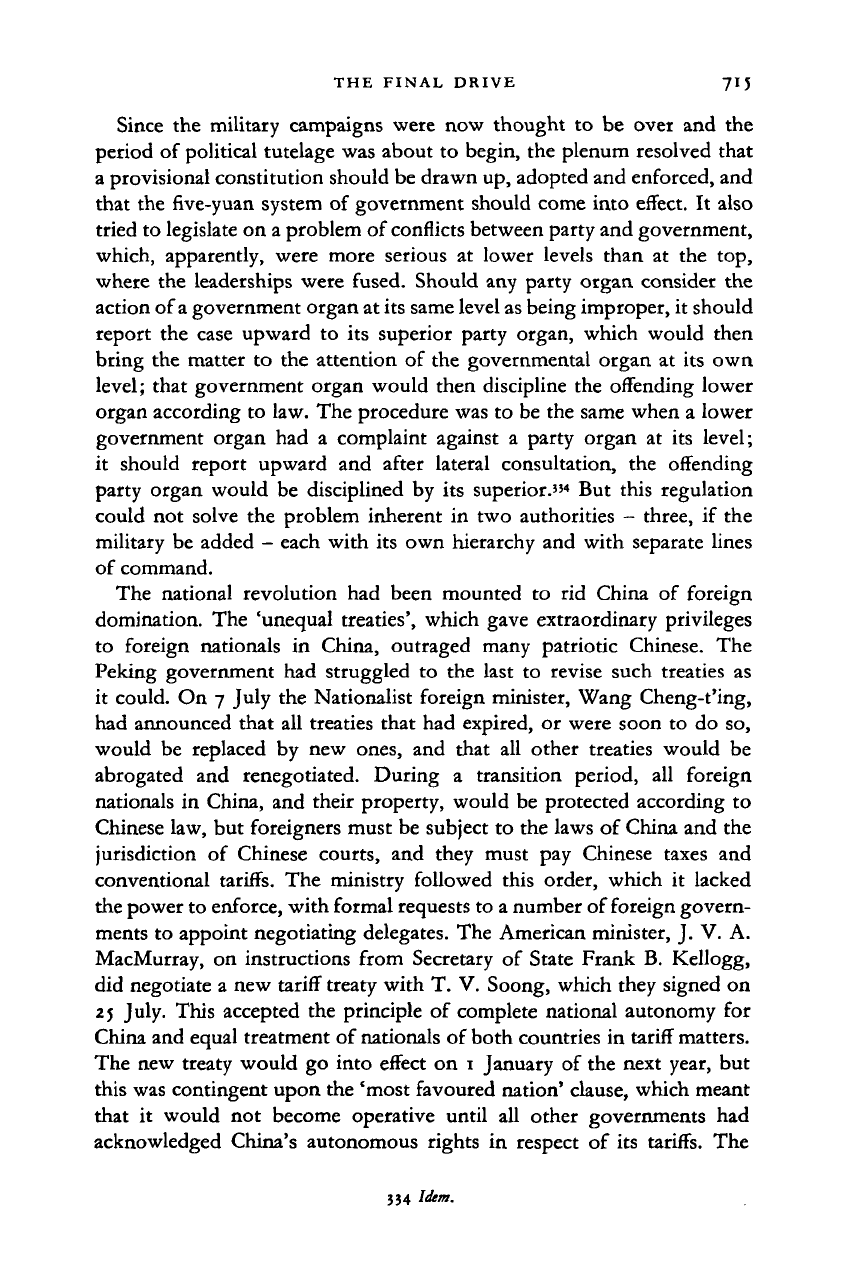
THE FINAL DRIVE 715
Since the military campaigns were now thought to be over and the
period of political tutelage was about to begin, the plenum resolved that
a provisional constitution should be drawn up, adopted and enforced, and
that the five-yuan system of government should come into effect. It also
tried to legislate on a problem of conflicts between party and government,
which, apparently, were more serious at lower levels than at the top,
where the leaderships were fused. Should any party organ consider the
action of a government organ at its same level as being improper, it should
report the case upward to its superior party organ, which would then
bring the matter to the attention of the governmental organ at its own
level; that government organ would then discipline the offending lower
organ according to law. The procedure was to be the same when a lower
government organ had a complaint against a party organ at its level;
it should report upward and after lateral consultation, the offending
party organ would be disciplined by its superior.'
34
But this regulation
could not solve the problem inherent in two authorities - three, if the
military be added - each with its own hierarchy and with separate lines
of command.
The national revolution had been mounted to rid China of foreign
domination. The 'unequal treaties', which gave extraordinary privileges
to foreign nationals in China, outraged many patriotic Chinese. The
Peking government had struggled to the last to revise such treaties as
it could. On 7 July the Nationalist foreign minister, Wang Cheng-t'ing,
had announced that all treaties that had expired, or were soon to do so,
would be replaced by new ones, and that all other treaties would be
abrogated and renegotiated. During a transition period, all foreign
nationals in China, and their property, would be protected according to
Chinese law, but foreigners must be subject to the laws of China and the
jurisdiction of Chinese courts, and they must pay Chinese taxes and
conventional tariffs. The ministry followed this order, which it lacked
the power to enforce, with formal requests to a number of foreign govern-
ments to appoint negotiating delegates. The American minister, J. V. A.
MacMurray, on instructions from Secretary of State Frank B. Kellogg,
did negotiate a new tariff treaty with T. V. Soong, which they signed on
25 July. This accepted the principle of complete national autonomy for
China and equal treatment of nationals of both countries in tariff matters.
The new treaty would go into effect on 1 January of the next year, but
this was contingent upon the 'most favoured nation' clause, which meant
that it would not become operative until all other governments had
acknowledged China's autonomous rights in respect of its tariffs. The
334 Idem.
Cambridge Histories Online © Cambridge University Press, 2008
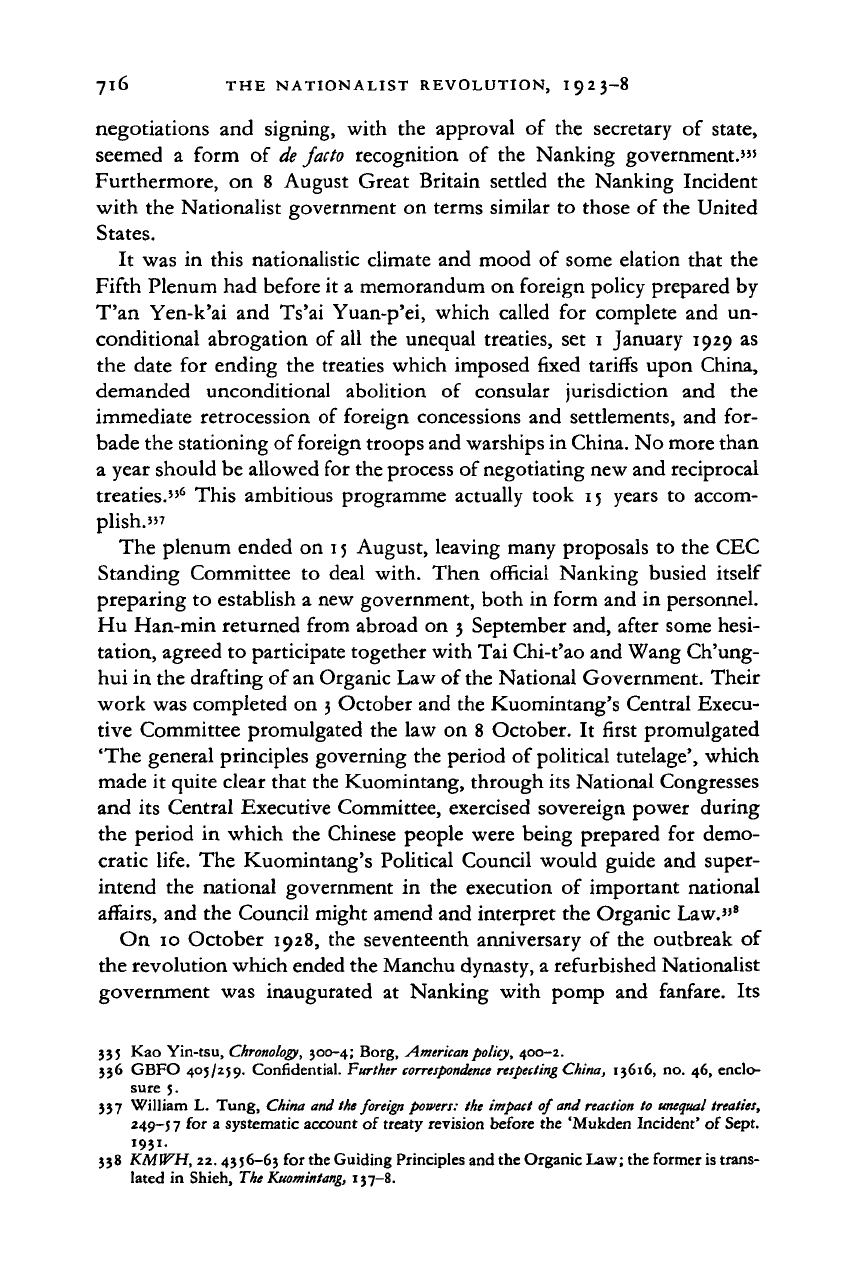
716 THE NATIONALIST REVOLUTION, I923-8
negotiations
and
signing, with
the
approval
of the
secretary
of
state,
seemed
a
form
of
de
facto recognition
of the
Nanking government."
5
Furthermore,
on 8
August Great Britain settled
the
Nanking Incident
with the Nationalist government on terms similar
to
those of the United
States.
It was
in
this nationalistic climate and mood
of
some elation that the
Fifth Plenum had before it a memorandum on foreign policy prepared by
T'an Yen-k'ai
and
Ts'ai Yuan-p'ei, which called
for
complete and
un-
conditional abrogation
of
all the unequal treaties,
set i
January 1929
as
the date
for
ending the treaties which imposed fixed tariffs upon China,
demanded unconditional abolition
of
consular jurisdiction
and the
immediate retrocession
of
foreign concessions and settlements, and for-
bade the stationing of foreign troops and warships in China. No more than
a year should be allowed for the process of negotiating new and reciprocal
treaties."
6
This ambitious programme actually took
15
years
to
accom-
plish.'"
The plenum ended on 15 August, leaving many proposals to the CEC
Standing Committee
to
deal with. Then official Nanking busied itself
preparing to establish a new government, both in form and in personnel.
Hu Han-min returned from abroad on 3 September and, after some hesi-
tation, agreed to participate together with Tai Chi-t'ao and Wang Ch'ung-
hui in the drafting of an Organic Law of the National Government. Their
work was completed on
3
October and the Kuomintang's Central Execu-
tive Committee promulgated the law
on
8 October.
It
first promulgated
'The general principles governing the period of political tutelage', which
made
it
quite clear that the Kuomintang, through its National Congresses
and its Central Executive Committee, exercised sovereign power during
the period
in
which the Chinese people were being prepared
for
demo-
cratic life. The Kuomintang's Political Council would guide and super-
intend the national government
in the
execution
of
important national
affairs, and the Council might amend and interpret the Organic Law."
8
On 10 October 1928, the seventeenth anniversary
of
the outbreak
of
the revolution which ended the Manchu dynasty, a refurbished Nationalist
government was inaugurated
at
Nanking with pomp
and
fanfare.
Its
335 Kao Yin-tsu,
Chronology,
300-4; Borg, American
policy,
400-2.
336 GBFO 405/259. Confidential. Further
correspondence respecting
China, 13616, no. 46, enclo-
sure
5.
337 William
L.
Tung, China and
the foreign
powers: the impact of and
reaction
to
unequal
treaties,
249-5 7 for
a
systematic account
of
treaty revision before the 'Mukden Incident'
of
Sept.
1931.
338
KMWH,
22. 4356-63 for the Guiding Principles and the Organic Law; the former is trans-
lated
in
Shieh, The
Kuomintang,
137-8.
Cambridge Histories Online © Cambridge University Press, 2008
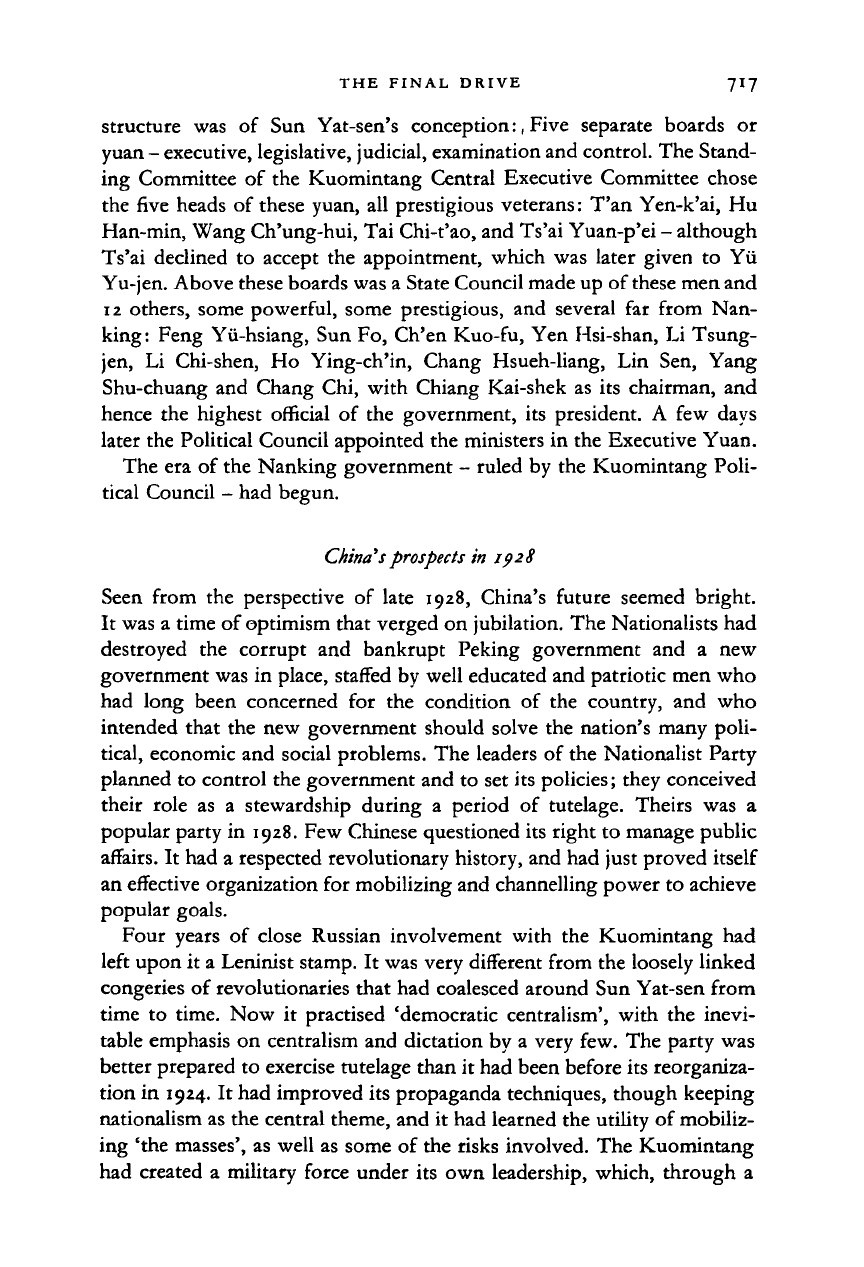
THE FINAL DRIVE 717
structure was of Sun Yat-sen's conception:, Five separate boards or
yuan - executive, legislative, judicial, examination and control. The Stand-
ing Committee of the Kuomintang Central Executive Committee chose
the five heads of these yuan, all prestigious veterans: T'an Yen-k'ai, Hu
Han-min, Wang Ch'ung-hui, Tai Chi-t'ao, and Ts'ai Yuan-p'ei - although
Ts'ai declined to accept the appointment, which was later given to Yii
Yu-jen. Above these boards was a State Council made up of
these
men and
12 others, some powerful, some prestigious, and several far from Nan-
king: Feng Yii-hsiang, Sun Fo, Ch'en Kuo-fu, Yen Hsi-shan, Li Tsung-
jen, Li Chi-shen, Ho Ying-ch'in, Chang Hsueh-liang, Lin Sen, Yang
Shu-chuang and Chang Chi, with Chiang Kai-shek as its chairman, and
hence the highest official of the government, its president. A few days
later the Political Council appointed the ministers in the Executive Yuan.
The era of the Nanking government - ruled by the Kuomintang Poli-
tical Council - had begun.
China sprospects in 1928
Seen from the perspective of late 1928, China's future seemed bright.
It was a time of optimism that verged on jubilation. The Nationalists had
destroyed the corrupt and bankrupt Peking government and a new
government was in place, staffed by well educated and patriotic men who
had long been concerned for the condition of the country, and who
intended that the new government should solve the nation's many poli-
tical, economic and social problems. The leaders of the Nationalist Party
planned to control the government and to set its policies; they conceived
their role as a stewardship during a period of tutelage. Theirs was a
popular party in 1928. Few Chinese questioned its right to manage public
affairs. It had a respected revolutionary history, and had just proved itself
an effective organization for mobilizing and channelling power to achieve
popular goals.
Four years of close Russian involvement with the Kuomintang had
left upon it a Leninist stamp. It was very different from the loosely linked
congeries of revolutionaries that had coalesced around Sun Yat-sen from
time to time. Now it practised 'democratic centralism', with the inevi-
table emphasis on centralism and dictation by a very few. The party was
better prepared to exercise tutelage than it had been before its reorganiza-
tion in 1924. It had improved its propaganda techniques, though keeping
nationalism as the central theme, and it had learned the utility of mobiliz-
ing 'the masses', as well as some of the risks involved. The Kuomintang
had created a military force under its own leadership, which, through a
Cambridge Histories Online © Cambridge University Press, 2008
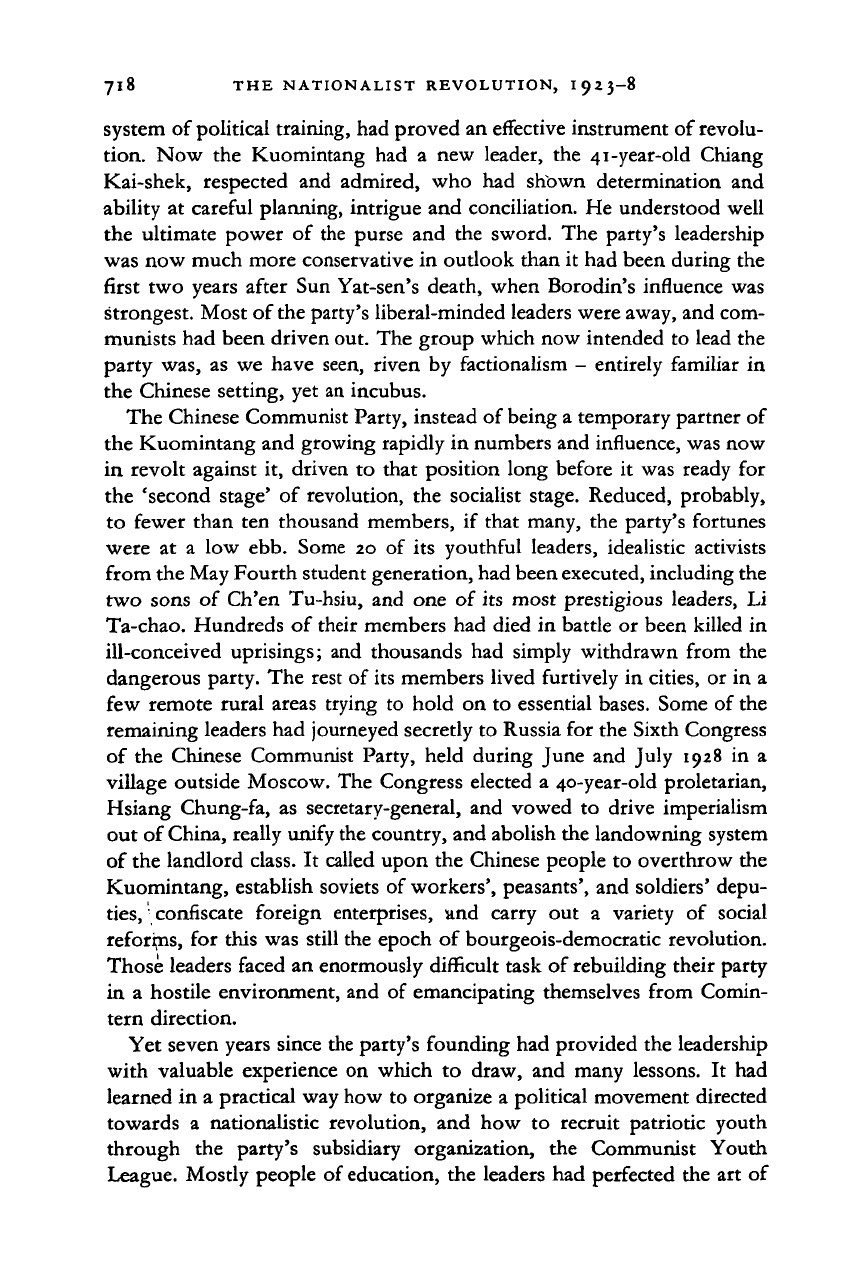
718 THE NATIONALIST REVOLUTION, 1923-8
system of political training, had proved an effective instrument of revolu-
tion. Now the Kuomintang had a new leader, the 41-year-old Chiang
Kai-shek, respected and admired, who had shown determination and
ability at careful planning, intrigue and conciliation. He understood well
the ultimate power of the purse and the sword. The party's leadership
was now much more conservative in outlook than it had been during the
first two years after Sun Yat-sen's death, when Borodin's influence was
strongest. Most of the party's liberal-minded leaders were away, and com-
munists had been driven out. The group which now intended to lead the
party was, as we have seen, riven by factionalism - entirely familiar in
the Chinese setting, yet an incubus.
The Chinese Communist Party, instead of being a temporary partner of
the Kuomintang and growing rapidly in numbers and influence, was now
in revolt against it, driven to that position long before it was ready for
the 'second stage' of revolution, the socialist stage. Reduced, probably,
to fewer than ten thousand members, if that many, the party's fortunes
were at a low ebb. Some 20 of its youthful leaders, idealistic activists
from the May Fourth student generation, had been executed, including the
two sons of Ch'en Tu-hsiu, and one of its most prestigious leaders, Li
Ta-chao. Hundreds of their members had died in battle or been killed in
ill-conceived uprisings; and thousands had simply withdrawn from the
dangerous party. The rest of its members lived furtively in cities, or in a
few remote rural areas trying to hold on to essential bases. Some of the
remaining leaders had journeyed secretly to Russia for the Sixth Congress
of the Chinese Communist Party, held during June and July 1928 in a
village outside Moscow. The Congress elected a 40-year-old proletarian,
Hsiang Chung-fa, as secretary-general, and vowed to drive imperialism
out of China, really unify the country, and abolish the landowning system
of the landlord class. It called upon the Chinese people to overthrow the
Kuomintang, establish Soviets of workers', peasants', and soldiers' depu-
ties,
:
confiscate foreign enterprises, and carry out a variety of social
reforms, for this was still the epoch of bourgeois-democratic revolution.
Those leaders faced an enormously difficult task of rebuilding their party
in a hostile environment, and of emancipating themselves from Comin-
tern direction.
Yet seven years since the party's founding had provided the leadership
with valuable experience on which to draw, and many lessons. It had
learned in a practical way how to organize a political movement directed
towards a nationalistic revolution, and how to recruit patriotic youth
through the party's subsidiary organization, the Communist Youth
League. Mostly people of education, the leaders had perfected the art of
Cambridge Histories Online © Cambridge University Press, 2008
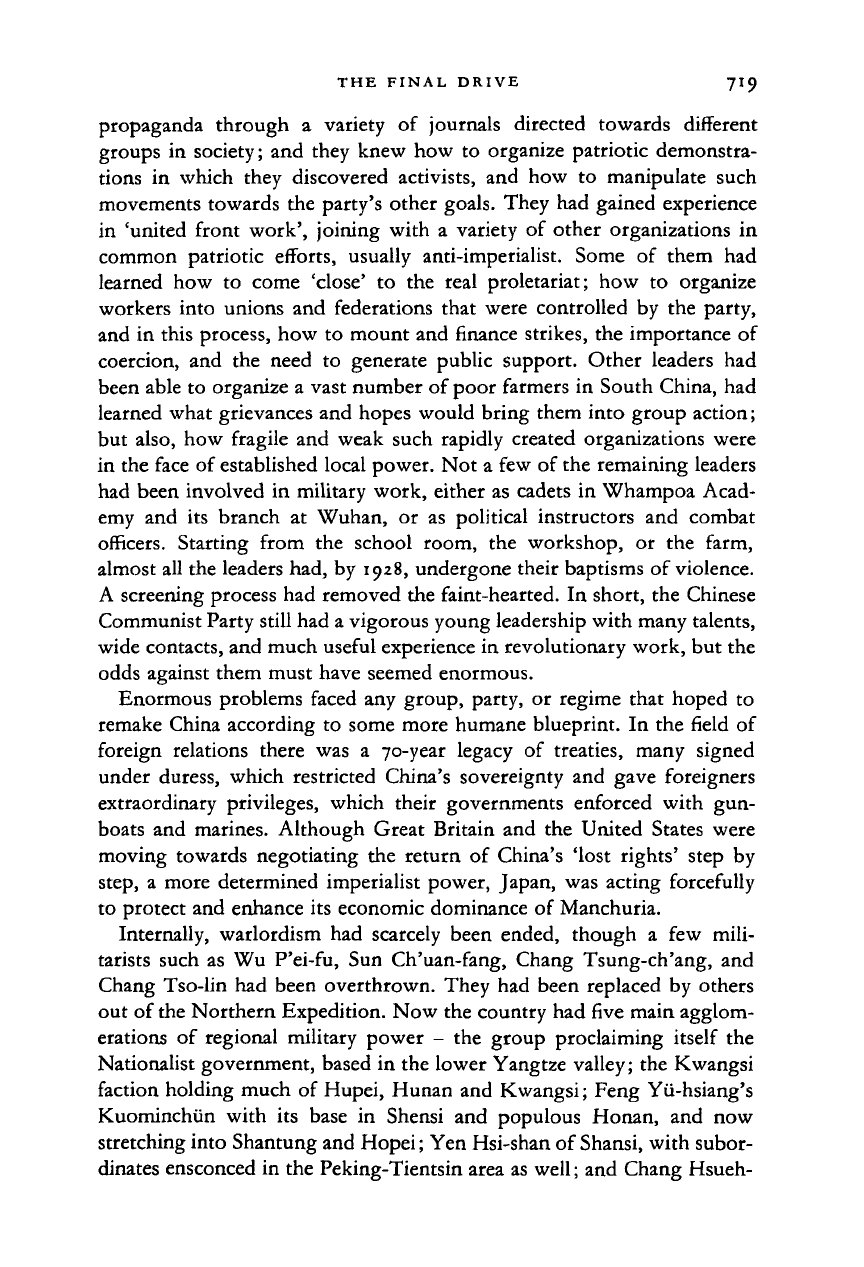
THE FINAL DRIVE 719
propaganda through a variety of journals directed towards different
groups in society; and they knew how to organize patriotic demonstra-
tions in which they discovered activists, and how to manipulate such
movements towards the party's other goals. They had gained experience
in 'united front work', joining with a variety of other organizations in
common patriotic efforts, usually anti-imperialist. Some of them had
learned how to come 'close' to the real proletariat; how to organize
workers into unions and federations that were controlled by the party,
and in this process, how to mount and finance strikes, the importance of
coercion, and the need to generate public support. Other leaders had
been able to organize a vast number of poor farmers in South China, had
learned what grievances and hopes would bring them into group action;
but also, how fragile and weak such rapidly created organizations were
in the face of established local power. Not a few of the remaining leaders
had been involved in military work, either as cadets in Whampoa Acad-
emy and its branch at Wuhan, or as political instructors and combat
officers. Starting from the school room, the workshop, or the farm,
almost all the leaders had, by 1928, undergone their baptisms of violence.
A screening process had removed the faint-hearted. In short, the Chinese
Communist Party still had a vigorous young leadership with many talents,
wide contacts, and much useful experience in revolutionary work, but the
odds against them must have seemed enormous.
Enormous problems faced any group, party, or regime that hoped to
remake China according to some more humane blueprint. In the field of
foreign relations there was a 70-year legacy of treaties, many signed
under duress, which restricted China's sovereignty and gave foreigners
extraordinary privileges, which their governments enforced with gun-
boats and marines. Although Great Britain and the United States were
moving towards negotiating the return of China's 'lost rights' step by
step,
a more determined imperialist power, Japan, was acting forcefully
to protect and enhance its economic dominance of Manchuria.
Internally, warlordism had scarcely been ended, though a few mili-
tarists such as Wu P'ei-fu, Sun Ch'uan-fang, Chang Tsung-ch'ang, and
Chang Tso-lin had been overthrown. They had been replaced by others
out of the Northern Expedition. Now the country had five main agglom-
erations of regional military power - the group proclaiming itself the
Nationalist government, based in the lower Yangtze valley; the Kwangsi
faction holding much of Hupei, Hunan and Kwangsi; Feng Yii-hsiang's
Kuominchiin with its base in Shensi and populous Honan, and now
stretching into Shantung and Hopei; Yen Hsi-shan of Shansi, with subor-
dinates ensconced in the Peking-Tientsin area as well; and Chang Hsueh-
Cambridge Histories Online © Cambridge University Press, 2008
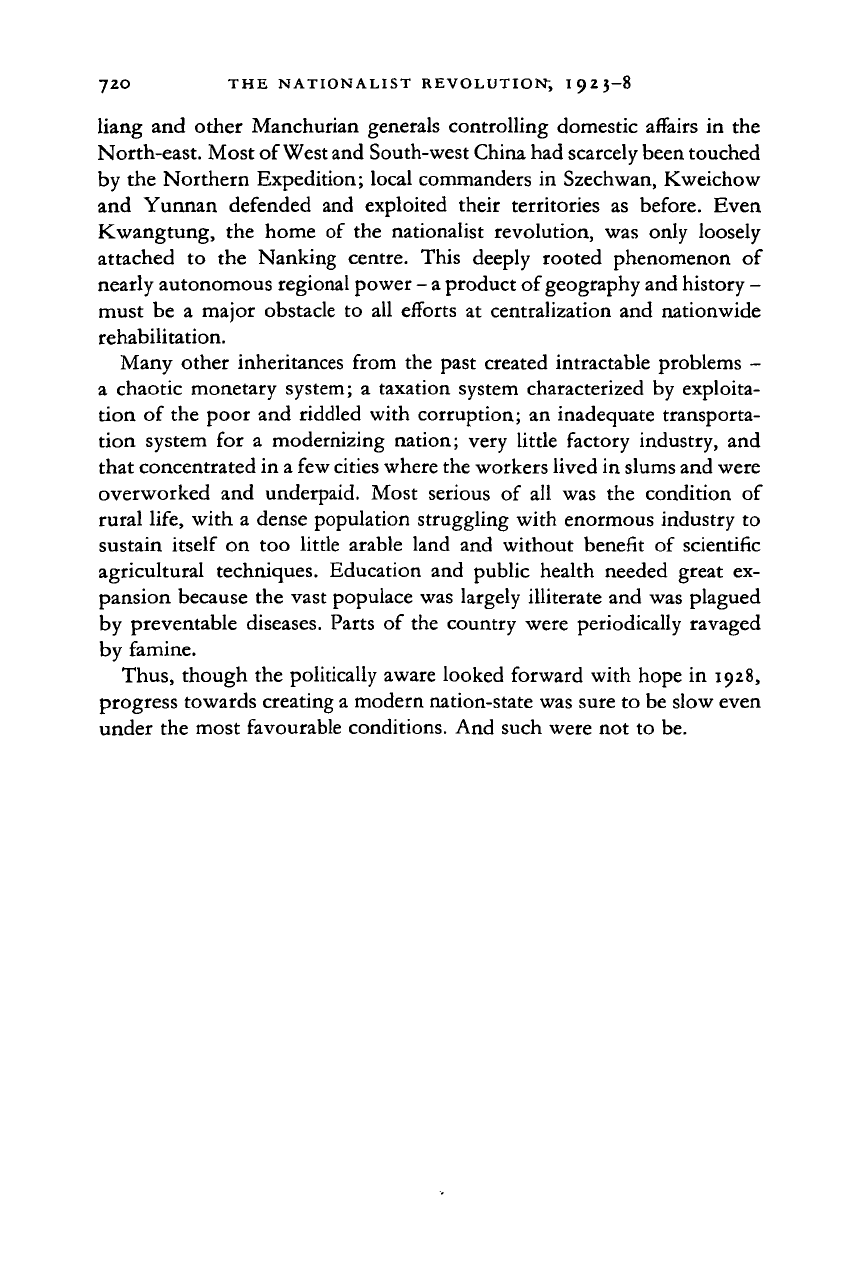
720 THE NATIONALIST REVOLUTION; I 923-8
Hang and other Manchurian generals controlling domestic affairs in the
North-east. Most of West and South-west China had scarcely been touched
by the Northern Expedition; local commanders in Szechwan, Kweichow
and Yunnan defended and exploited their territories as before. Even
Kwangtung, the home of the nationalist revolution, was only loosely
attached to the Nanking centre. This deeply rooted phenomenon of
nearly autonomous regional power - a product of geography and history -
must be a major obstacle to all efforts at centralization and nationwide
rehabilitation.
Many other inheritances from the past created intractable problems -
a chaotic monetary system; a taxation system characterized by exploita-
tion of the poor and riddled with corruption; an inadequate transporta-
tion system for a modernizing nation; very little factory industry, and
that concentrated in a few cities where the workers lived in slums and were
overworked and underpaid. Most serious of all was the condition of
rural life, with a dense population struggling with enormous industry to
sustain itself on too little arable land and without benefit of scientific
agricultural techniques. Education and public health needed great ex-
pansion because the vast populace was largely illiterate and was plagued
by preventable diseases. Parts of the country were periodically ravaged
by famine.
Thus,
though the politically aware looked forward with hope in 1928,
progress towards creating a modern nation-state was sure to be slow even
under the most favourable conditions. And such were not to be.
Cambridge Histories Online © Cambridge University Press, 2008
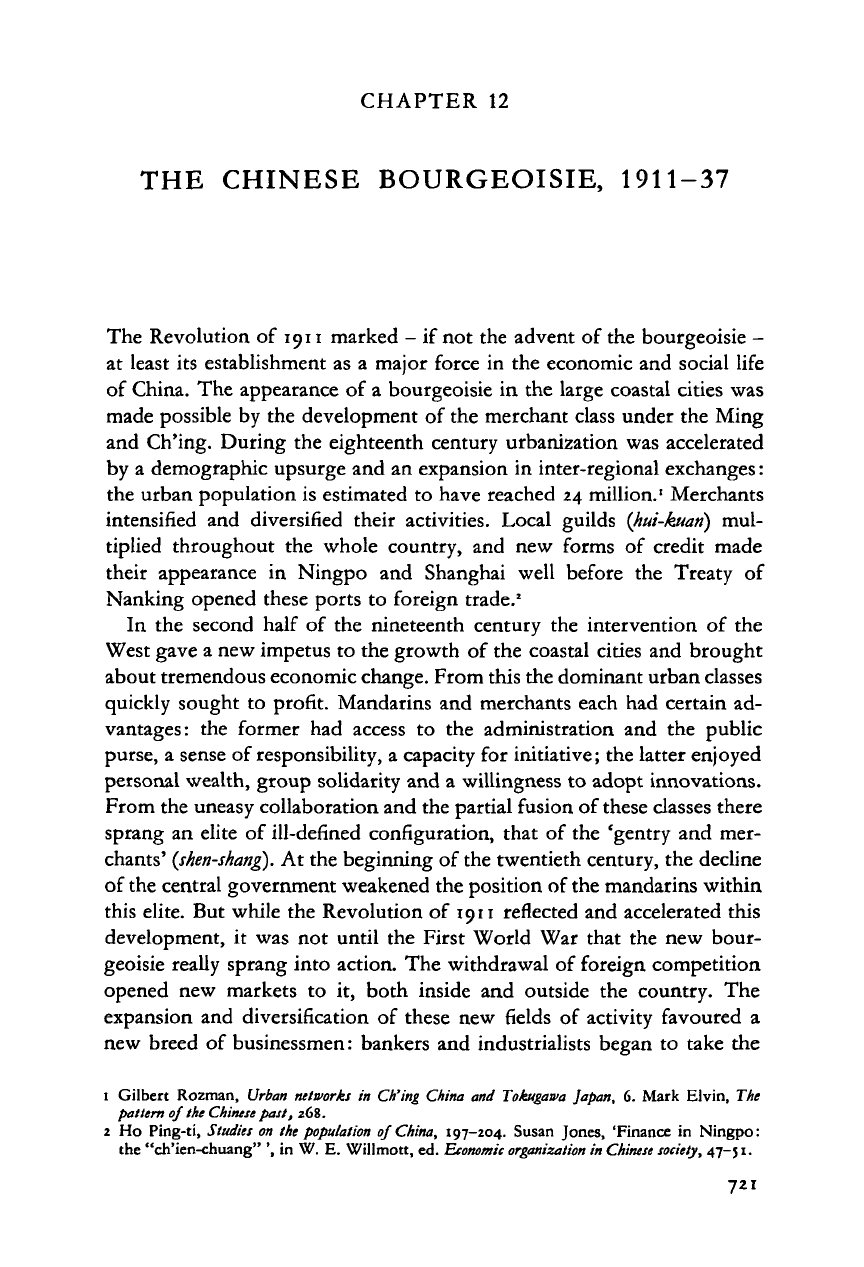
CHAPTER
12
THE CHINESE BOURGEOISIE, 1911-37
The Revolution
of
1911 marked
- if
not the advent
of
the bourgeoisie
-
at least its establishment
as a
major force
in
the economic and social life
of China. The appearance
of a
bourgeoisie
in
the large coastal cities was
made possible by the development
of
the merchant class under the Ming
and Ch'ing. During the eighteenth century urbanization was accelerated
by
a
demographic upsurge and an expansion
in
inter-regional exchanges:
the urban population is estimated
to
have reached 24 million.
1
Merchants
intensified
and
diversified their activities. Local guilds
(Jiui-kuari)
mul-
tiplied throughout
the
whole country,
and new
forms
of
credit made
their appearance
in
Ningpo
and
Shanghai well before
the
Treaty
of
Nanking opened these ports
to
foreign trade.
2
In
the
second half
of the
nineteenth century
the
intervention
of the
West gave a new impetus
to
the growth
of
the coastal cities and brought
about tremendous economic change. From this the dominant urban classes
quickly sought
to
profit. Mandarins
and
merchants each had certain ad-
vantages:
the
former
had
access
to the
administration
and the
public
purse,
a
sense of responsibility,
a
capacity
for
initiative; the latter enjoyed
personal wealth, group solidarity and
a
willingness
to
adopt innovations.
From the uneasy collaboration and the partial fusion of these classes there
sprang
an
elite
of
ill-defined configuration, that
of
the 'gentry
and
mer-
chants'
(shen-shang).
At the beginning
of
the twentieth century, the decline
of the central government weakened the position of the mandarins within
this elite. But while the Revolution
of
1911 reflected and accelerated this
development,
it
was
not
until
the
First World
War
that
the
new bour-
geoisie really sprang into action. The withdrawal
of
foreign competition
opened
new
markets
to it,
both inside
and
outside
the
country.
The
expansion
and
diversification
of
these
new
fields
of
activity favoured
a
new breed
of
businessmen: bankers
and
industrialists began
to
take
the
1 Gilbert Rozman, Urban networks
in
Ch'ing China and
Tokugawa
japan,
6.
Mark Elvin, The
pattern of
the Chinese
past, 268.
2
Ho
Ping-ti, Studies on the
population
of
China,
197-204. Susan Jones, 'Finance
in
Ningpo:
the "ch'ien-chuang" *,
in
W.
E.
Willmott, ed.
Economic organization
in
Chinese
society,
47-51.
721
Cambridge Histories Online © Cambridge University Press, 2008
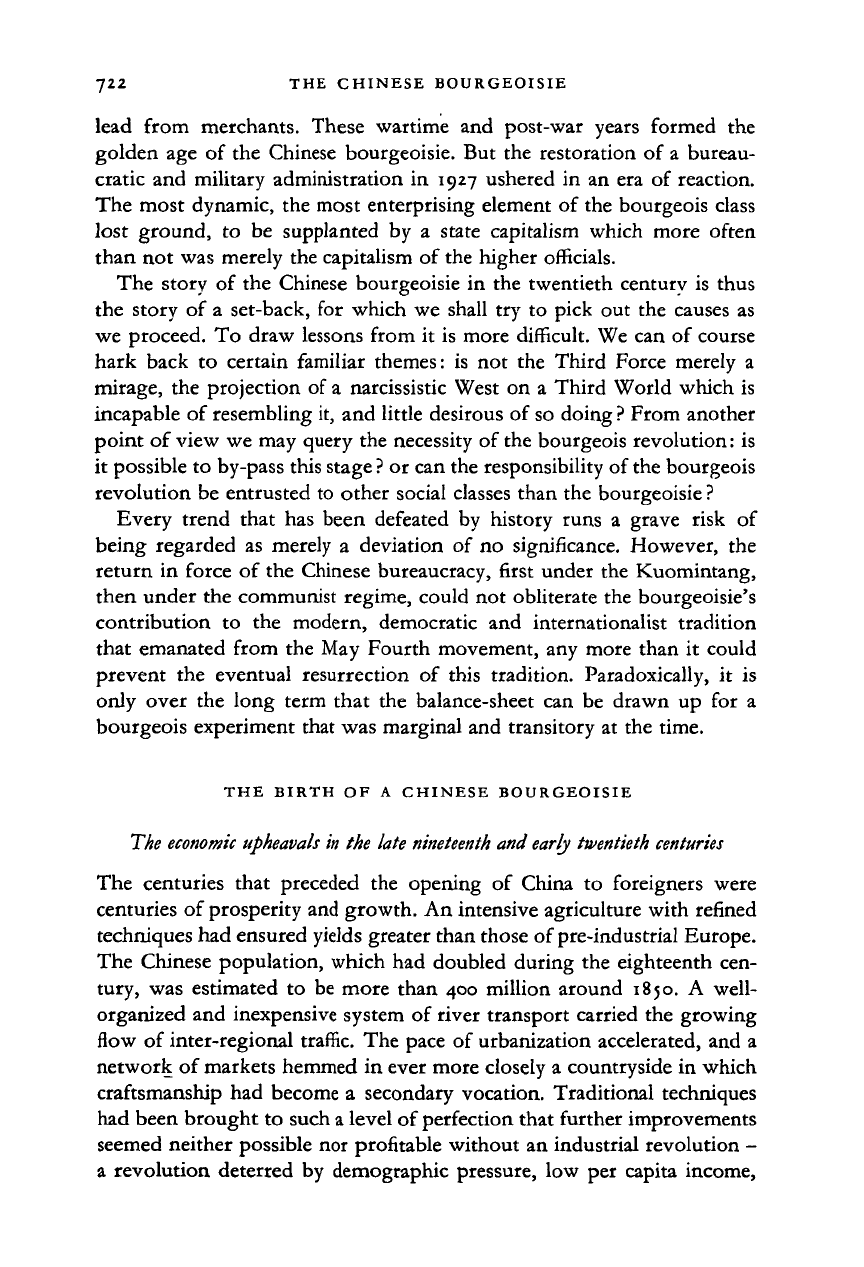
722 THE CHINESE BOURGEOISIE
lead from merchants. These wartime and post-war years formed the
golden age of the Chinese bourgeoisie. But the restoration of a bureau-
cratic and military administration in 1927 ushered in an era of reaction.
The most dynamic, the most enterprising element of the bourgeois class
lost ground, to be supplanted by a state capitalism which more often
than not was merely the capitalism of the higher officials.
The story of the Chinese bourgeoisie in the twentieth century is thus
the story of a set-back, for which we shall try to pick out the causes as
we proceed. To draw lessons from it is more difficult. We can of course
hark back to certain familiar themes: is not the Third Force merely a
mirage, the projection of a narcissistic West on a Third World which is
incapable of resembling it, and little desirous of so doing
?
From another
point of view we may query the necessity of the bourgeois revolution: is
it possible to by-pass this stage
?
or can the responsibility of the bourgeois
revolution be entrusted to other social classes than the bourgeoisie
?
Every trend that has been defeated by history runs a grave risk of
being regarded as merely a deviation of no significance. However, the
return in force of the Chinese bureaucracy, first under the Kuomintang,
then under the communist regime, could not obliterate the bourgeoisie's
contribution to the modern, democratic and internationalist tradition
that emanated from the May Fourth movement, any more than it could
prevent the eventual resurrection of this tradition. Paradoxically, it is
only over the long term that the balance-sheet can be drawn up for a
bourgeois experiment that was marginal and transitory at the time.
THE BIRTH OF A CHINESE BOURGEOISIE
The
economic
upheavals in the late
nineteenth
and
early
twentieth
centuries
The centuries that preceded the opening of China to foreigners were
centuries of prosperity and growth. An intensive agriculture with refined
techniques had ensured yields greater than those of pre-industrial Europe.
The Chinese population, which had doubled during the eighteenth cen-
tury, was estimated to be more than 400 million around 1850. A well-
organized and inexpensive system of river transport carried the growing
flow of inter-regional traffic. The pace of urbanization accelerated, and a
network of markets hemmed in ever more closely a countryside in which
craftsmanship had become a secondary vocation. Traditional techniques
had been brought to such a level of perfection that further improvements
seemed neither possible nor profitable without an industrial revolution -
a revolution deterred by demographic pressure, low per capita income,
Cambridge Histories Online © Cambridge University Press, 2008
